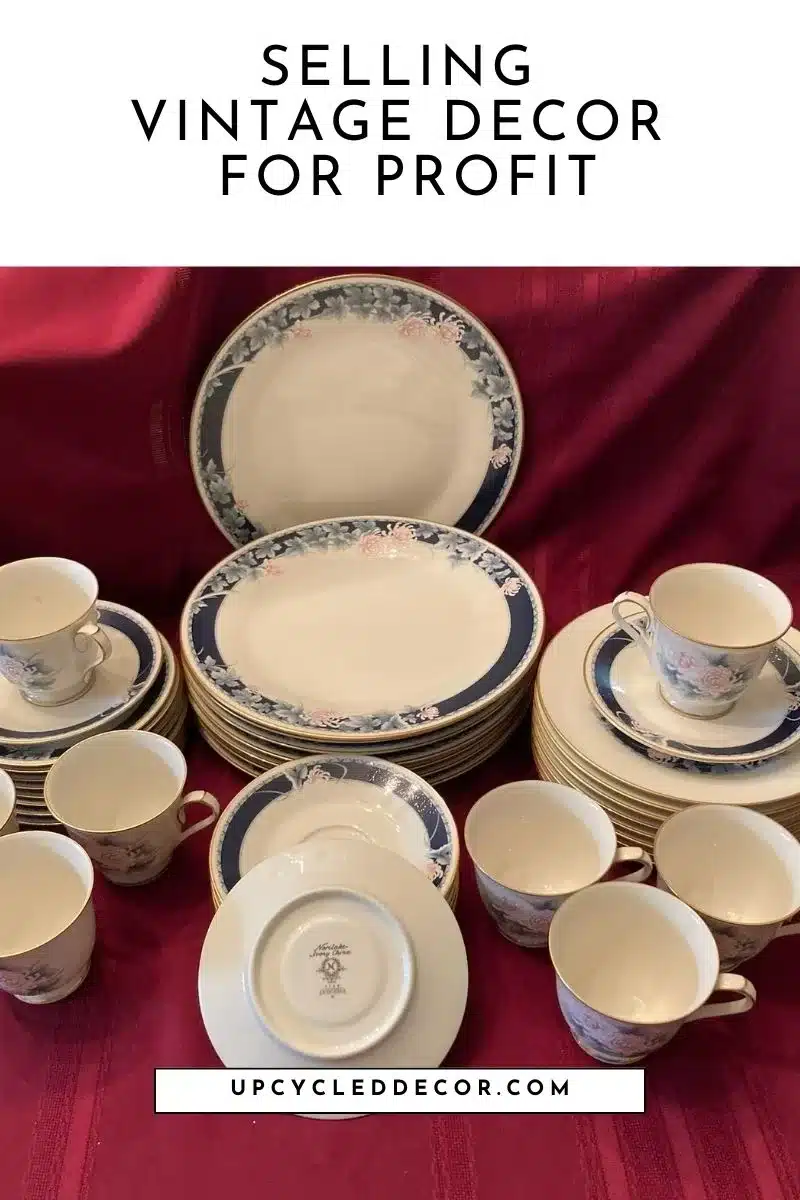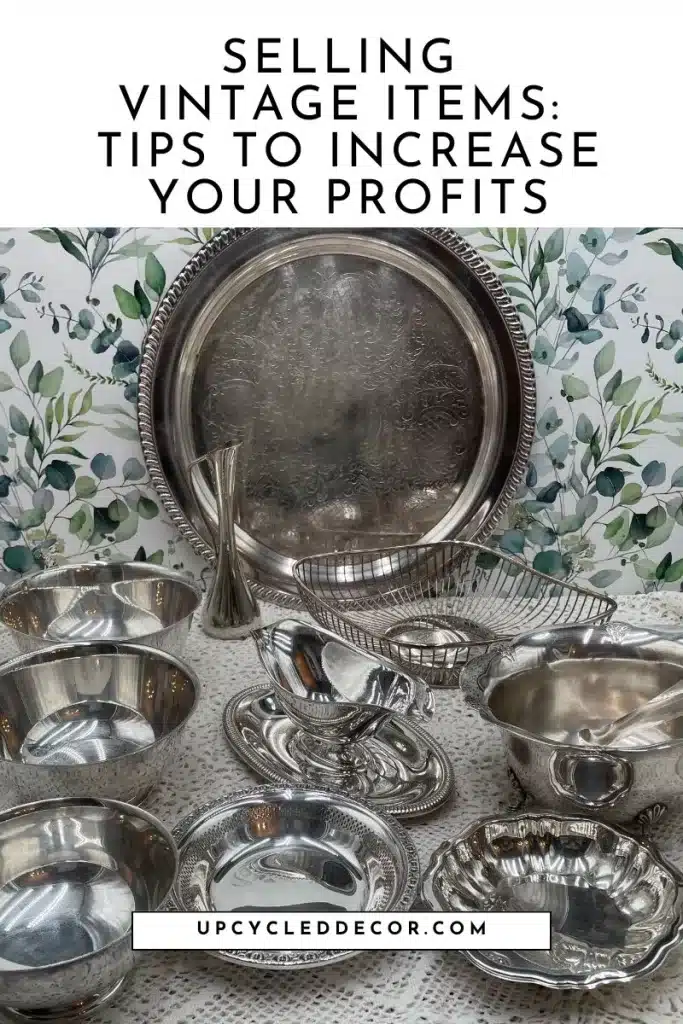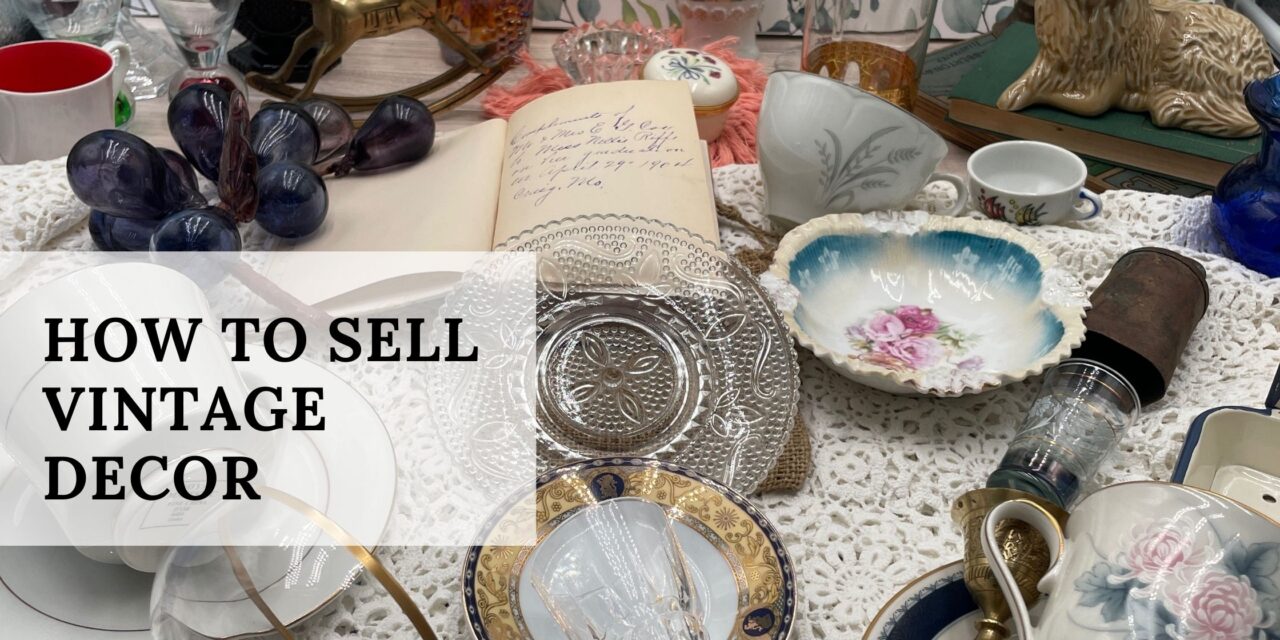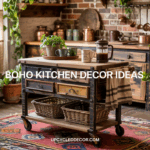This is an article about how to make money selling vintage decor as a business.
This post may contain affiliate links, which means I’ll receive a commission if you purchase through my link, at no extra cost to you. Please read full disclosure here.
If you love vintage decor for your own home, you want to build a side hustle making money, and you care about the planet–selling vintage decor could be the dream business for you. We started from zero dollars (seriously, like no money) and now we have a five-figure business. You can sell

These vintage dishes are equally great to keep for yourself or resell!
Where to buy vintage items to resell
If you want to sell vintage decor for profit, you need to a decent amount of volume..eventually. But we started with nothing and built up. You can obviously start with items you own, or curbside finds. Go to garage sales at the end of the day–we have gotten beautiful vintage plates (plural) for a dollar. Even free! We sold exclusively in person, at first. And even if we only made $10-15 per item, it was a decent way to make money to put back into the business.
As soon as we had $20-50 of profit, we supplemented our curbside finds and personal inventory with items we purchased. Garage sales let us buy a few items at a very low risk price, plus we often scored some freebies.
Garage sales and moving sales are great sources for vintage home decor to sell.
There are multiple advantages to going to to garage sales when you first start selling vintage decor for profit. One upside of garage sales is that you can often get matching items there, or items that complement each other. After all a homeowner usually likes what they like, so their decor will usually be somewhat consistent. That can be true for similar price point (people who buy Crate & Barrel likely buy from West Elm or Pottery Barn also). And the same holds true for similar purchases by style and color scheme.
Buying in bundles can help you save money, and it can be better to resell vintage decor in bundles.
And if you’re going to buy enough to bundle–you can also bargain for yourself. Ask the seller if they will discount for bundles! (We’ve yet to be told no, and we’ve been to hundreds of garage sales.) The seller is usually pretty motivated at garage sales. Think about it–anything they sell is one less thing to pack or donate or pull back in the house!

Unique and unusual items like this vintage pottery fruit bowl are great vintage decor finds.
Often people will have a handful of high value items that they are less willing to negotiate. They know the items is worth enough money that it’s worth the hassle and waiting for a fair price. Don’t bother trying to get someone to come down on something priced at, say, $200 and expect it to come down to $10. Focus on items that are less than $50. And be polite, if they say a firm no. If they counter with something higher than you can afford, just decline cheerfully.
This isn’t just about decent manners (though, there’s that). It’s about building relationships with your sources. Selling vintage decor for a profit means buying vintage
Vintage silver is timeless and often a lucrative choice for resellers.

Thrift stores can be a great place for variety and plentiful vintage decor to sell.
Thrift stores are also a great place to start, but you’ll need at least a little starter budget. What sells well for you starts off as trial and error, however. Obviously it’s the safer the more you can get for free or really cheap (literally we spent no more than $3 on a single item when we started). That way, if things don’t sell, you aren’t out a lot of money.
If you live far from vintage stores, or only have one or two to choose from, you might find it worth your while to travel to a larger town. Again, you’ll need a budget to justify the trip, but, if you’re in a small town without many thrift stores, you have a captive audience to sell to. People can buy online, but there’s a good market for people who prefer to pick something up in-person. They don’t have to worry about shipping or breakage, they can inspect the item, and they can often get it faster. (Pro tip: if you’re selling vintage decor for profit, you need to think like a buyer!)
Finding vintage decor at thrift stores.
Anyone who has spent five minutes on TikTok looking up vintage decor has seen the bright blue Goodwill shopping cart videos and people bragging about their thrift store hauls. We think thrift stores are great, especially if you have $25 to $50 in your pocket. We started our business focused mostly on flipping furniture, and initially we turned to curbside finds, garage sales and thrift stores.
Then we quickly expanded to vintage decor! And thrift stores are even more affordable–there are countless opportunities to pick up vintage teacups (usually $1.99 at our store) and teapots ($3.99 to $5.99). We also recommend vintage vases and vintage dishes as good finds. Be sure to check the label or mark on the bottom and try to see if it’s vintage. We Google Lens stuff a ton in the store. Finally, triple check for chips, cracks and other damage.
Pros of thrift store shopping:
The are multiple advantages to shopping at thrift stores for vintage decor. For one, the inventory is always changing, and if you love the thrill of the hunt, you’ll find a lot here. Unlike a garage sale or estate sale, you can keep going back, and keep a record of which stores consistently offer the best items. We even track which days to go where. Tuesdays tend to be best at our Goodwills–this tends to be true in stores that get a lot of weekend donations. It can take them most of Monday to sort and price things, which means Tuesday is the best day to go. We do find Mondays are good at stores with smaller weekend donations.
Cons of thrift store shopping:
Higher prices. You *can* get good prices–even great prices–at thrift stores, but not always. In our experience, you can still get fantastic prices on items like vintage dishes and vintage glassware, as well as
Shopping at thrift stores will help you grow your vintage decor resale business.
It can take a lot of time. We go some weeks for an hour or more, and walk out empty-handed. The other con, you can’t negotiate (usually). This isn’t always a problem, but we have noticed prices have become much higher over the last year. (And if Reddit is any indicator, it’s not just our local stores, either.)
Buying vintage decor online: how to get bargains for your thrift reselling business
Whether to start buying online. We rarely bought online to resell when we first started selling vintage decor. It also depends on whether you are buying vintage decor for yourself, or buying vintage decor to resell for a profit. If you are buying for yourself, then you don’t need to buy low enough to make a profit. But if you are just getting started selling vintage decor, and you’re going to start off selling locally, you’ll need to sell at a limited price. Once we started selling vintage decor online, especially on Etsy, we could reach a much bigger audience (although we also had higher costs). But to begin, garage sales and moving sales can be a great place to start.
Online marketplaces for in-person pickup–like Marketplace, OfferUp and NextDoor–can be a great place to get vintage decor to resell. But you can also buy online if the options locally are limited. The biggest challenge will be you have to factor shipping into your prices when you go to resell. One tip: start small (literally) if you can find non-breakable vintage items like flatware, or copper tea cups, or small collectibles like trinkets. Those can ship for less but may price better at resale.
Avoid buying online dinner sets or other large heavy items that are low price points. And when starting out, if you have to buy online try to avoid breakables. When you’re on a tight budget time is money and you don’t want to waste a lot time dealing with broken arrivals.
Shopping at estate sales for vintage decor to sell can be great–if you have a budget.
We have written before about how to shop estate sales and get great bargains. And we really do love them! But if we were starting from nothing, we would suggest you skip the estate sales. You will get great prices compared to full retail, but you’re less likely to actually get something for a dollar or two. You might be able to get free stuff at an estate sale on the last day, during the last hour. But, we find that very rare–and we’ve hung around to the end of estate sales pretty frequently!
Where to resell vintage decor items when you are starting your business
Selling vintage decor IRL is a great way to start your reselling business. We love Etsy and Poshmark and there’s a ton of online options. But first, don’t sleep on how much you can make selling vintage decor right at home. We were surprised at how much you can sell just around town. There is always the problem of how big your local market is. For example, we live in the suburbs of a major city so there are tons of potential customers…and a ton of competition. And because it’s a big city, people usually won’t drive too far if there’s another offer that’s closer. Of course, if you live in a smaller town, you might have fewer customers but fewer competitors.
It’s also cheaper for you as a seller to resell thrift decor locally. No upfront costs like starting an Etsy account. You don’t need any packaging materials, or even gas money to take items to the post office. No one takes a cut of your sales either: you will pay 5%-10% in reselling fees on Etsy, Poshmark, Ebay or any other major platform. And of course, you get paid instantly when you sell vintage decor locally, which is great for cash flow.
How to make money reselling vintage items
Profits then pricing. When we started the business, our first stage of thrifting was just making enough money to buy more inventory. Every dollar we made went right back into the business: we didn’t dream of paying ourselves right away. We just wanted to not have to spend any of our money to get started.
One way to make money is fast, but not a lot (high volume), the other way is the opposite. You can sell slowly and wait for a higher margin. Eventually, we did both. But with a few exceptions, we sold items at any reasonable profit (we tried to make at least $10 on each sale), so we could start having a steady cash flow.
Selling a lot of things quickly also helped us learn quickly what sold and what didn’t. You might want to note what sold really fast (under a week). We even made notes if it sold for a lot of profit. We had to update “a lot” over time, but to start anything over $25 profit was a lot!
All of this helped us get smarter quickly about what kinds of items to buy and what to pass on in the future. We also began to test different markets for different items.
Repeat business: Don’t underestimate plain old good customer service to sell vintage decor.
Repeat customers surprised us at first–but if you sell items at a good price, in good condition (and with good photos that are accurate)–you can actually get a following. We were surprised how many people were delighted to learn our items worked when we said they did. If we said no cracks…there were no cracks. On places like Facebook (Meta) Marketplace and OfferUp, we started to get good reviews. And then we began to hear people not just ask if it was available, but even tell us they had bought from us before. People even put in requests! “DM me if you get any more brass floor lamps.”
So it’s worth considering just selling in-person when you first start. The costs of selling online come with some additional start up fees. That’s not to say it hasn’t been worth it–we’ve tripled our income and doubled our profits by selling online. But, we were making thousands of dollars per month selling vintage decor and flipping furniture before we were doing really any online sales.
You can read about the strategy we followed to build a furniture flipping business (and thrift decor sales) to a five-figure business.

Don’t forget to share and save!
If you enjoyed this article, please don’t forget to share and save!
This is an article about how to make money selling vintage decor as a business.







